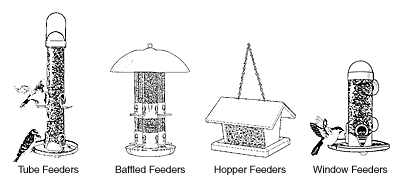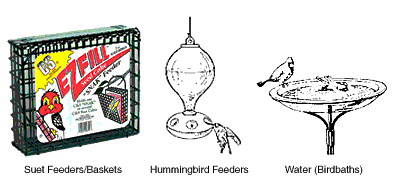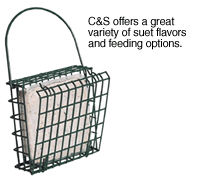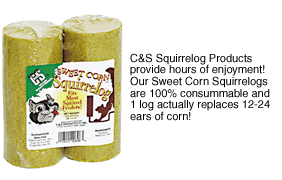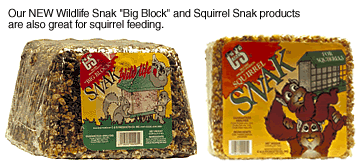An Introduction to Wild Bird & Squirrel Feeding
Wild Bird Feeding is one of the nation’s greatest pastimes and is the second largest outdoor recreational hobby in America today (second only to gardening). Over 85 million people annually feed birds in the U.S. “Birders”, which is the term used for people who feed birds, can range anywhere from a person who has multiple feeders in their yard and is passionate about bird feeding, to a person that may scatter bread crumbs in extreme weather out of sympathy.
Understanding Wild Birds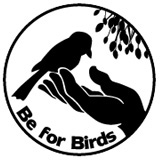
BENEFITS:
Why Feed the Birds?
Why would anyone want to feed the wild birds? This question may be raised more often than you think. Many associate wild birds with dive bombing raids on newly washed cars, and as a general nuisance. However, there are several reasons why one would want birds in their yard and why millions each year actively attract and feed these creatures.
First off, wild birds are extremely beneficial to a yard and those who enjoy the great outdoors. Wild birds eat large quantities of insects, and are one of the best natural means of keeping these pests under control year-round.
Second, the varied and vibrant colors of many birds brighten up any yard and add value to landscaping. Birds add liveliness and music to gardens in all seasons. Birds also keep children occupied. Children can acquire an early interest in nature by watching them flock to a backyard feeder. Wild Bird feeding is also extremely educational. There is a trend back towards nature, and wild bird feeding is one of those means.
Third, wild bird feeding makes us feel good. Especially in cold weather – when easy meals at the backyard bird feeder can often make the difference between life and death. Birds are wild creatures so they bring an element of nature right into a homeowner’s yard, up close, where it can be observed every day. The innovative C&S product selection makes birds easy to attract.
Last, bird feeding in general is an inexpensive hobby compared to other pursuits and provides excellent entertainment value. Before we review the various details and bird feeding basics, it is important to understand wild birds and their needs. From there we can then review suggestions on how best to get them into your yard and feeding from your feeders.
Understanding Wild Birds
An average yard in this country, where feeders are placed, is visited on a regular basis by 15-20 different species of wild birds. Some yards are visited by more than a hundred. Much of this depends on where one lives and the particular season.
Opportunities for watching birds in the yard are best in winter since birds will travel long distances in search of food and energy. However, the greatest varieties come in the spring and fall, when birds are passing in migration.
The most widespread visitor to bird feeders currently is the Dark-eyed Junco. Research shows over 80% of the bird feeders in this country have been visited by this variety of bird. Geographically, in the southeast the most numerous birds are Cardinals; Blue Jays in the northeast; Black-capped Chickadees in the northwest; and House Finches in the Southwest.
Wild birds are generally divided into three categories: winter visitors; summer nesters; and “Birds of Passage.” There is overlap within these groups. However, there is a noticeable change in backyard bird life based on seasonal changes.
Basically, birds need and search for the following (if a bird can find all of this, then it’s truly a happy life):
- FOOD. Birds eat many foods other than seed and suet. Insects, spiders, grubs and worms, nuts, soft fruits and berries, tree sap, flower nectar, leaves and grass, trees and shrubs, eggs and nestling stolen from another bird’s nest, other birds, fish, and small animals are all examples of primary bird food. However, the birds that customers primarily wish to attract to their yards are seed or suet eaters. The Northern Cardinal is an example of a seed-eating bird and the Chickadee as a suet eating bird.
- WATER. Birds need to consume water to survive. Sometimes a strategically placed birdbath or pool can attract a greater variety of birds than the foods that are provided.
- COVER. Birds need protective cover. Flying is their way of surviving or escaping an attack. Thus, birds are most vulnerable when they are "grounded" to rest, feed or nest. Protective cover denotes plant or tree cover, or even geological formations, such as cliffs or high rocky ledges.
- A PLACE TO RAISE THEIR YOUNG. Nests, nesting holes, and birdhouses are places of refuge as well as places where birds can raise their young. There is perhaps nothing more exciting in feeding birds than observing the nesting and raising of their young. Convenient sources of water and food are vital factors in determining where birds will raise their young,
Now that we have their motivation, let’s take a look at how we can best feed them and where all human wild bird feeding begins… with the bird feeder.
Wild Bird Feeders
Types of Feeders
There are several different types of bird feeders that work in attracting wild birds to a yard. The basic types of bird feeders that attract wild birds are:
1. TUBE FEEDERS. Available in plastic and/or metal-reinforced models. Tube feeders are one of the most popular styles of feeder available because they are easy-to-fill, hang, and hold a lot of seed.
2. BAFFLED FEEDERS/SQUIRREL BAFFLERS. These are typically feeders that come with a squirrel baffle, which is typically a dome-like or spherical device that protects seed from squirrels.
3. PLATFORM or GROUND FEEDERS. Generally a flat “platform” constructed of wood, or using the ground itself, platform feeders do tend to waste significant amounts of seed due to theft by squirrels and other predators. However, they are excellent for attracting birds like Cardinals, who do not readily visit perched or hopper-type feeders.
4. HOUSE or HOPPER-TYPE FEEDERS. Usually constructed of wood, these feeders usually have an attractive, rustic look. Larger models hold large quantities of seed and allow several birds to perch at once.
5. WINDOW FEEDERS. Usually constructed of plastic and containing a “suction-cup” for easy mounting to windows, this feeder brings nature right up to a window! However, extreme care should be used when using window feeders because birds will have a tendency to crash into the window if it is too clear. These feeders also don’t hold a lot of seed, but can bring hours of watching and listening enjoyment.
6. SUET & FRUIT BASKETS/FEEDERS. These types of feeders, generally consisting of a plastic-coated wire (so bird feet do not freeze to direct metal), can accommodate anything from a single suet cake to fruit, bread and donuts depending on the size of the basket/feeder. Other examples of this type of feeder would be suet nets or “thistle socks” (for feeding Niger Thistle seed to finches).
7. HUMMINGBIRD/ORIOLE FEEDERS. These are generally “liquid” feeders that contain a delivery system of nectar or sweet liquids for Hummingbirds and fruit-loving birds. Hummingbird and Oriole feeding (using “orange” nectar, which is very attractive to Orioles) has become increasingly popular.
8. NUGGET/PEANUT FEEDERS. This style feeder uses a 1/3″ mesh design that Nuggets, Peanuts or Sunflower may be pulled through. Birds must cling to this style feeder making it more difficult for many of the larger unwanted birds to feed from. Designed for specialty foods that will attract songbirds and other colorful wild birds that all hobbyist desire.
9. WATER. We consider water a food source because fresh water is essential to any bird-attracting program. Many birds that don’t eat the foods provided in feeders often will be drawn to a yard or garden by water. One of the best ways to provide water would be through the use of a birdbath.
Choosing a Feeder
It is always best to invest in a well-made feeder in the beginning, because it will last a long time and will reward you with years of enjoyment. Of course, beginners will usually gravitate to promotional or economy grade feeders. Here are some features that you should consider when purchasing a feeder:
- A wild bird feeder should be easy-to-fill with large openings. You may also wish to purchase funnels or special birdseed scoops for convenience in filling a feeder.
- It should hold plenty of seed so you don't have to fill it as often.
- It should be easy to take apart and clean.
- Clear parts should be plastic and not glass (preferably Lexan brand plastic, which is unbreakable, shatterproof, and cannot be chewed by squirrels and other predators).
- It should protect the seed from rain and snow. Also important--drainage (small holes on the bottom or sides to protect against moisture, and consequently, spoilage).
- It should have metal perches and reinforced openings (if a tube feeder), so squirrels cannot chew them.
- It should have a manufacturer’s guarantee (where applicable).
Today’s bird feeders are relatively strong and built to last. Of course, “you get what you pay for” and the promotional feeders (plastics) are not designed to last as long as higher priced feeders. However, with proper care, bird feeders can last for years.
Feeders should be cleaned regularly by thoroughly scrubbing with hot water and detergent. Always dispose of any old or moldy food at all of your feeders, including ground feeders, to avoid any possible harm to the birds (A clean feeder increases bird consumption and repeat visits).
Attracting & Feeding Wild Birds
Attracting Wild Birds to Feeders & Yards
To review, wild birds need food, water, cover, and a place to raise their young. But there are so many other aspects to providing wild birds all of the things that they need to survive and thrive. The following is a review of exactly how to attract wild birds, as well as information on suet feeding and gardening for wild birds.
There are many types of seed and suet feeders currently available. However, there are several considerations your customers need to be aware of when purchasing a feeder. All are excellent tips for attracting wild birds to feeders and yards.
- LOCATION. A feeder should manipulate birds so they can be properly viewed. The type of feeder you choose will determine where it can be placed. However, some birds may never come to a feeder if they are either too close to the house, or make them sitting targets for other predators (lacking proper cover).
- HEIGHT OF THE FEEDER. As important as location is how high the feeder should be situated. A good program for attracting wild birds to a yard would include: some ground feeding; a platform feeder on a post about 5 feet off the ground; a few hopper, tube or Nugget feeders suspended by wires anywhere from 5-8’ high; a thistle feeder; a window feeder; and a suet feeder mounted on tree trunks at various heights. Combined, you now have the beginnings of a fine aviary!
- VARIETY OF FEEDER PLACEMENT. If there is space, consider having 2 or 3 different bird feeding areas or stations, each about 50 feet apart. When placed in and around different vegetation and at different heights--the multiple feeders will attract more varieties of birds. In winter, birds favor the most sheltered locations out of the freezing wind.
- PROTECTING THE FEEDER. Feeding stations are not just attractive to birds, but nuisance birds (like Starlings), squirrels, and cats. Nuisance birds primarily prefer ground feeding, so you may wish to select a site well away from the house and feeders to scatter seed to draw nuisance birds away from bird feeders. Squirrels will be covered in detail later in this review. A cat can also be a nuisance to wild birds. If the cat is used to being in the yard, hang a bell around the cat’s neck (to warn birds) or keep feeders about 15 feet away from shrubbery, overhanging limbs, or other hiding places.
Suet Feeding
Suet feeding was once relegated to just winter feeding, but now has become a year-round activity and supplements a regular seed feeding program (and in some cases replaces seed altogether). Suet is a high-energy source of food for birds, but used to have a bad connotation because it was messy and greasy. The new generation suet produced by C&S uses rendered beef kidney fat and seed, fruit combinations that may be easily fed year round. We also have a suet “dough” form that won’t melt for those extremely hot southern areas.
To fill a suet feeder, simply take off the plastic wrap, keeping the suet in the plastic container, and insert into a suet basket. Hang the basket so that the suet is facing upside down–wild birds like to eat suet from this angle. No mess–no melting–and an excellent source of energy fat and protein to wild birds when they need it most. Suet has come long way from the corner butcher and is now a highly refined product that is easy-to-use and extremely rewarding.
NEW! Nuggets Plus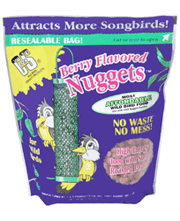
As bird feeders have grown into a major category with a variety of options, so has bird food. C&S has recently introduced new NUGGETS PLUS™, which are suet based product produced in a Nugget form and blended with roasted peanuts. Songbirds love suet and they love peanuts, thus, combining the two seemed only natural. This is for the serious bird feeder. No waste, no mess and available in a variety of flavors. Excellent for use with Nugget, Peanut or Sunflower feeders using a 1/3″ plus opening. Also works well with all styles of platform feeders. NUGGETS PLUS™ may also be blended with 5-10 lbs. of your favorite wild bird seed mix. This mix may then be fed from tube or hopper style feeders.
Seed Blends Plus Nuggets
C&S New Ultra, Superior and Premium Seed Blends go a step beyond the others by incorporating our New Berry Nuggets, roasted peanuts, sunflower hearts, berries, black sunflower and white millet. These no waste no mess mixes may be used in all standard tube or hopper seed feeders and will attract a wider variety of songbirds than normal seed mixes.
Gardening for Birds
The most important concept to understand in attracting wild birds is variety. Birds live in different habitats and the greater the variety of habitats that are created – the more birds and species that will be attracted. Key elements in creating different habitats is offering food and nest sites at all levels. This can be accomplished by keeping gardening for wild birds in mind.
There are basically four levels of habitats that may be created and maintained in a yard:
- GRASS LEVEL. Anywhere from 2 inches to 1 foot high (this would represent just a portion of your yard, not the whole yard).
- SHRUB LEVEL. 2 to 5 feet high. The best bird plantings at this level would include Honeysuckle (shrubs, not vines), Junipers (that grow from 2 to 5 feet tall), and Barberry.
- SMALL TREE LEVEL. 5 to 15 feet high. The best bird plantings at this level are Crab Apple (get trees that have abundant, small apples), Juniper (get species that grow from 10 to 20 feet tall), and Hawthorn.
- TALL TREE LEVEL. 15 to 40 feet high. Try to offer a variety of foliage and foods at this level. The best bird plantings at this level are Pines, Spruce, and Hemlock (for cones and cover); Maple, Ash, Elm and Birch (for seeds); Cherry, Mulberry, and Mountain Ash (for berries); and Oak (for nuts).
There are many easy and inexpensive ways to create a variety of habitats:
- Create one or more loose piles of brush with limbs, branches, and old Christmas Trees.
- Let a part of the lawn grow tall and don’t mow it. Minimum area would be 10 feet by 10 feet.
- If there is part of the yard that is overgrown with weeds and shrubs - leave it alone.
- Leave dead trees standing and dead limbs on trees, as long as they are not a hazard or eyesore.
- If surrounded by trees, cut down a few to make a little clearing. On the other hand, if surrounded by clearing, plant a few shrubs and trees.
This section on gardening for wild birds would not be complete without a look at nesting sites where birds can raise their young. To facilitate this, make nesting boxes or birdhouses available to your customers. They can be placed anywhere from 3 to 10 feet high on a tree or post (basically anywhere that is not disturbed by human activity). For best results, put up a birdhouse in the fall or winter so the birds have a chance to get used to it.
Dealing with Squirrels
If you can’t beat ‘em… Feed ‘em!
When it comes to squirrels, there is a simple solution to this problem and that is: If you can’t beat ‘em. Feed ‘em!
If a bird feeder is put in an area with a lot of squirrel activity, the chances are they will probably be attracted to it. After all, they are being offered a free meal and they simply assume that it is intended for them. Some people get so obsessed with keeping squirrels away that bird feeding tends to become an unpleasant experience. These people often forget to enjoy the beauty of the wildlife they have attracted and squirrels can be quite fun on their own. However, if you are looking for a way to rid your feeders of squirrels (because it is virtually impossible to rid a yard of them) here are a few tips.
The key is to divert the attention of squirrels away from bird feeders. Squirrel feeders are often designed to have a table and chair with a nail coming from the top of the table. A squirrel will sit down and enjoy their feast just as the feeder suggests. The nail can easily accommodate a C&S Squirrelog (the favorite food of squirrels) or an ear of corn, but the problem with an ear of corn is that it does not last long (a squirrel can polish off a complete ear of corn in about a half an hour or less). The C&S Squirrelogs are produced with compressed Sweet Corn and offer more food and entertainment value for the dollar. One Squirrelog equals 20+ ears of corn. For more entertainment use our Squirrelog Hanger that creates a moveable unstable feeder that the squirrels will go into contortions to eat from.
C&S also offers a variety of squirrel feeding products, such as our new WILDLIFE “BIG BLOCK” SNAK and SQUIRREL SNAK items. These products are made to withstand even the most voracious squirrels as well as provide a steady diet of sweet corn–a squirrel’s favorite.
However, sometimes it is not enough to just feed the squirrels. They are voracious eaters and, unless continually fed, they will go after bird feeders. Thus, a customer may need to “baffle” the squirrels. As previously noted, there are a number of baffling devices for use on squirrels and it is recommended that baffling devices be used whenever and wherever there is squirrel activity. After all, squirrels stealing birdseed from feeders is one worry–another is that they will chew on them and destroy them over a matter of time. To baffle squirrels and keep them from a feeder, take the following steps:
- Hang the feeder at least 8 feet way from the nearest access, such as a tree trunk or limb, and 5 to 6 feet off the ground. Even this may require a few adjustments if the squirrels have excellent jumping ability. If squirrels are using seed trays as a landing platform, remove the trays.
- Use Squirrel Baffles—umbrella-shaped physical barriers that squirrels are unable to crawl over on any wire that leads to the feeder. Another tip—lubricate the baffles (Vaseline or WD-40, for example) so that the squirrel simply slides off rapidly.
- On a pole-mounted feeder, place baffles at least 4 feet up on the pole below the feeder. Remember to keep the feeder far enough away from trees or anything that the squirrel could use to jump from so they cannot jump to it.
- Place your Squirrelog or Snak Cake squirrel feeders away from your wild bird feeders.
Trying to prevent squirrels from getting at bird feeders can be an experience, but also a rewarding one at which everyone can marvel at the determination and acrobatic skills of these fun creatures.
Troubleshooting and Feeding Issues
The following are three questions that are often asked in regard to wild bird feeding.
THERE ARE NO BIRDS AT MY FEEDER?
Be sure that you’ve followed the steps that were mentioned earlier and use the right kind of feeders, plantings, and food for your yard. Above all, be patient–if you feed them they will come! The following are several other reasons why birds may not be feeding at a feeder: it may be the wrong season (at certain times of the year, late Summer and early Fall for example, there is an abundance of weed seeds and berries for birds to eat); wrong time of day; a change in bird feeding behavior (temperature, weather, time of year, time of day all influence a bird’s feeding habits); some species of wild birds only come to feeders in certain years; neighbors may have put up feeders (spreading out the birds); or you just may live in a spot with very few birds (lack of trees, shrubs, and cover).
CATS ARE EATING BIRDS AT MY FEEDER. WHAT TO DO?
Eliminate any possible hiding places for cats around feeders so birds can easily see them; place birdbaths off the ground and away from shrubbery where cats can hide; and fence in ground feeders that are near brush piles and shrubbery.
BIRDS KEEP CRASHING INTO OUR WINDOWS?
Birds see the reflections of sky and trees in windows and often mistake them for open space. This occurs often when they are frightened and suddenly take flight or when they are new to the area (like when they are migrating). There are several solutions to this problem: one, try to eliminate the reflection of the windows by putting up a screen; another is to make or buy a silhouette of a diving hawk or falcon and place it on the window. Birds recognize the shape as meaning danger and will stay away.
We hope you have enjoyed this review and have found it informative. Wild Bird Feeding is a dynamic and fun hobby. Feel free to close this window and browse around our site for more ideas and information on the best line of products available for wild bird and wildlife feeding.
THANK YOU FROM THE C&S TEAM!

